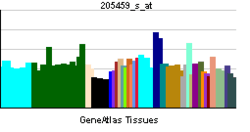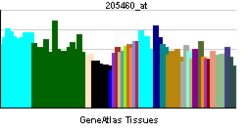NPAS2
| View/Edit Human | View/Edit Mouse |
Neuronal PAS domain-containing protein 2 is a protein that in humans is encoded by the NPAS2 gene.[3][4]
Function
The protein encoded by this gene is a member of the basic helix-loop-helix (bHLH)-PAS family of transcription factors. A similar mouse protein may play a regulatory role in the acquisition of specific types of memory. It also may function as a part of a molecular clock operative in the mammalian forebrain.[5]
NPAS2 has been shown to be analogous to the function of CLOCK in CLOCK deficient mice.[6]
Interactions
NPAS2 has been shown to interact with:
References
- ↑ "Human PubMed Reference:".
- ↑ "Mouse PubMed Reference:".
- ↑ Zhou YD, Barnard M, Tian H, Li X, Ring HZ, Francke U, Shelton J, Richardson J, Russell DW, McKnight SL (Mar 1997). "Molecular characterization of two mammalian bHLH-PAS domain proteins selectively expressed in the central nervous system". Proc Natl Acad Sci USA. 94 (2): 713–8. doi:10.1073/pnas.94.2.713. PMC 19579
 . PMID 9012850.
. PMID 9012850. - ↑ Hogenesch JB, Chan WK, Jackiw VH, Brown RC, Gu YZ, Pray-Grant M, Perdew GH, Bradfield CA (May 1997). "Characterization of a subset of the basic-helix-loop-helix-PAS superfamily that interacts with components of the dioxin signaling pathway". J Biol Chem. 272 (13): 8581–93. doi:10.1074/jbc.272.13.8581. PMID 9079689.
- ↑ "Entrez Gene: NPAS2 neuronal PAS domain protein 2".
- ↑ Debruyne JP (December 2008). "Oscillating perceptions: the ups and downs of the CLOCK protein in the mouse circadian system". J. Genet. 87 (5): 437–46. doi:10.1007/s12041-008-0066-7. PMC 2749070
 . PMID 19147932.
. PMID 19147932. - 1 2 McNamara P, Seo SB, Rudic RD, Sehgal A, Chakravarti D, FitzGerald GA (June 2001). "Regulation of CLOCK and MOP4 by nuclear hormone receptors in the vasculature: a humoral mechanism to reset a peripheral clock". Cell. 105 (7): 877–89. doi:10.1016/S0092-8674(01)00401-9. PMID 11439184.
- ↑ Hogenesch JB, Gu YZ, Jain S, Bradfield CA (May 1998). "The basic-helix-loop-helix-PAS orphan MOP3 forms transcriptionally active complexes with circadian and hypoxia factors". Proc. Natl. Acad. Sci. U.S.A. 95 (10): 5474–9. doi:10.1073/pnas.95.10.5474. PMC 20401
 . PMID 9576906.
. PMID 9576906. - ↑ Curtis AM, Seo SB, Westgate EJ, Rudic RD, Smyth EM, Chakravarti D, FitzGerald GA, McNamara P (February 2004). "Histone acetyltransferase-dependent chromatin remodeling and the vascular clock". J. Biol. Chem. 279 (8): 7091–7. doi:10.1074/jbc.M311973200. PMID 14645221.
External links
- NPAS2 protein, human at the US National Library of Medicine Medical Subject Headings (MeSH)
This article incorporates text from the United States National Library of Medicine, which is in the public domain.
This article is issued from Wikipedia - version of the 11/24/2016. The text is available under the Creative Commons Attribution/Share Alike but additional terms may apply for the media files.


